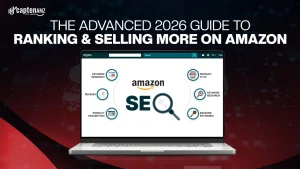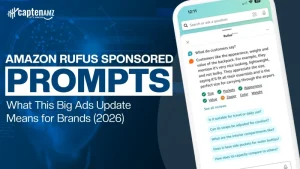If you’re running campaigns on Amazon and noticing that your Advertising Cost of Sales (ACoS) is creeping up, you’re likely asking: What’s wrong? Is it the keywords? The bids? The ad structure?
Here’s a bold claim: most of the time, the issue isn’t your ads themselves, it’s your creatives. In other words, it’s not necessarily your bidding strategy or campaign type; it’s what people actually see, hear, and feel when your ad pops up or directs them to your listing.
If you want to reduce ACoS on Amazon, you must start by auditing and upgrading your visuals and messaging. Your Amazon PPC creatives and Amazon advertising creatives hold enormous power, and they’re often overlooked.
Let’s unpack this thoroughly, step by step.
Table of Contents
ToggleUnderstanding ACoS: The Foundation

Before diving into how creatives impact your results, it’s important to understand what ACoS actually means and why it matters so much.
ACoS (Advertising Cost of Sales) tells you how much you’re spending on ads to generate each dollar of sales on Amazon. In simple terms, it’s the percentage of your ad spend compared to the sales your ads bring in.
The formula is:
ACoS = (Ad Spend ÷ Ad-Attributed Sales) × 100
Here’s what you need to know:
- Lower ACoS is usually better if your goal is to maximize profit.
- However, there’s no universal “good” ACoS; it depends on your product margin, niche competition, and business goals.
- A high ACoS doesn’t always mean your campaigns are failing; sometimes, it’s a strategic choice during product launches or brand-awareness campaigns.
- ACoS only measures sales directly linked to your ads. It doesn’t include organic sales growth influenced by advertising (that’s where TACoS, Total ACoS, comes in).
When you notice your ACoS rising, it’s natural to assume something’s wrong with your bids, keywords, or campaign settings.
But in many cases, those aren’t the real problem. The issue often lies in what shoppers see your creatives.
Why Creatives Matter More Than Most People Think

1. First Impressions Decide Everything
Your ad (whether a sponsored product, brand, or display) will appear among many others. A shopper glances at the thumbnail image, the headline or overlay text, maybe a short video. If the visual or messaging fails to persuade in 2-3 seconds, the click doesn’t happen. And if the click happens but the listing fails to deliver on the creative’s promise, the conversion doesn’t happen.
That means low CTR Amazon ads and poor conversion rates, both of which push your ACoS up.
Because when your ad doesn’t attract the right people (or doesn’t attract them well), you spend more to get fewer results.
2. Misalignment between Ad Promise and Listing Reality
Perhaps you have a great structure, good keywords, right match types, but the image in your ad, or the messaging, sets expectations your listing doesn’t fulfill. This creates a drop-off. People click, then bounce, then buy less, leading to higher ACoS.
Your creatives and your listing must work together. That’s why Amazon product listing optimization is inseparable from your ad-creative efforts.
3. Amazon’s Algorithm Rewards Performance
When your ad gets high CTR and drives strong conversions (relative to others in your niche), Amazon’s algorithm perceives your ad as more relevant and may favour it. That can drive down costs, improve ad placement, and positively impact your ACoS. When creatives are poor, those signals degrade.
4. Creative is the Underlying Lever that Many PPC Tactics can’t Fix
You can tweak bids, pause keywords, adjust targeting, shift budget, but if your visuals or messaging don’t resonate, you’re still bleeding money. It becomes “throwing more budget at a bad creative” rather than fixing the real root.
In short: before you pour money into more ads or sophisticated campaign setups, look at your creative and ask: Does this image + headline + copy persuade? Because that’s the first filter.
Common Creative Mistakes That Drive Up ACoS

Here are frequent culprits we see among sellers that lead to performance drain:
Mistake A: Generic, Low-Quality Images
- Blurry or low-resolution product photos.
- Images that look like stock photos, not branded or differentiated.
- No context or lifestyle use shown.
When images don’t make your product stand out, they fail to grab attention and your CTR suffers.
Mistake B: Messaging that doesn’t Highlight Value or Benefit
- Copy that focuses on features (“500ml capacity”, “ABS plastic”) but not on the benefit (“stay refreshed all day”, “durable for kids”).
- Headlines or overlays that are generic (“Best Widget Ever”) rather than specific and compelling.
This weakens the persuasive power of your ad and listing, reducing conversion rate and increasing your cost per acquisition.
Mistake C: Inconsistent Promise From Ad to Listing
- The ad creative promises “premium leather finish,” but the listing images show something cheap and plasticky.
- Ad claims “bundled accessories included,” but the listing bullets or images don’t mention that.
This mismatch kills trust, buyers bounce, returns increase, and PPC performance goes south.
Mistake D: Forgotten Mobile Optimization
- Many buyers shop via mobile, yet some creatives aren’t optimized for small screens (text too small, busy background, no clear focal point).
If your ad creative is cramped or unclear on mobile, you’ll lose potential clicks/conversions. That means wasted spend.
Mistake E: No Testing or Creative Refresh
- Using the same tired image or headline month after month. Creative fatigue sets in.
- Not testing variants (image A vs image B, headline X vs headline Y).
When creative performance drops, you’ll see rising ACoS unless you intervene.
Mistake F: Poor Alignment with Keywords/Audience
- Creative that doesn’t reflect the keyword intent. For example, you’re targeting “eco-friendly reusable water bottle” but your creative shows a gym scene with bright plastic bottles rather than an eco outdoors minimal design.
- In this case, clicks come in, but conversions don’t, you’re mismatched.
When you combine these errors, you set up a cascade: low click rates → fewer conversions → higher ad spend per sale → higher ACoS.
How to Diagnose: Is It the Creative or the Campaign?

Before you overhaul everything, you want to separate creative issues from other PPC issues. Here’s a diagnostic flow:
- Look at CTR (Click-through rate) for your campaigns/ads. If CTR is significantly below category benchmarks, suspect the creative/ad copy. Low CTR means your creative isn’t compelling enough.
- Look at Conversion Rate (on your listing after clicks). If clicks happen but conversions are low, suspect a listing or creative-listing mismatch.
- Compare multiple creatives within the same campaign. If one creative outperforms another significantly (with similar targeting/bidding), that’s a strong indicator.
- Control for targeting/bids: pick a campaign with steady, good targeting; swap out creatives and see if performance shifts. If yes, creativity is key.
- Check bounce/exit behaviour: do people click then immediately leave the listing? That suggests the ad promise doesn’t match the listing experience.
Once you’ve run this assessment, you’ll know whether to focus on campaign structure or creative overhaul. In many cases, the creative is the low-hanging fruit.
Creative Best Practices to Lower ACoS

Now, let’s talk about actionable tactics to optimize your creatives and thus improve your PPC efficiency. These are the same tactics top U.S. sellers and agencies use.
1. Prioritize High-Impact Main Image
- Use a clean white background (as Amazon often prefers), but also test variations with lifestyle overlay or context as allowed.
- Make sure the product is in focus, high resolution, and properly lit.
- Avoid distractions, no clutter, no excessive props that confuse the message.
- Highlight your differentiator (design, color, premium finish) visually.
This helps your ad stand out in search results and improves CTR.
2. Use Strong Lifestyle/Contextual Imagery
- Show your product in use: e.g., a water bottle in a gym, hiking trail, or office desk, depending on the target audience.
- Use an image that triggers emotion, an aspirational, problem-solving, or relatable scenario.
- Text overlay can call out a key benefit (“Keeps drinks cold 24h”, “Leak-proof guarantee”).
When you show the value visually, you’re helping with Amazon ad conversion optimization.
3. Create Infographic/Benefit-driven Images
- Use one or two images that clearly present why your product is better.
- Use icons or simple text for features & benefits (for readability on mobile).
- Use contrast, bold typography, and clarity.
Infographics help convert viewers into buyers faster, translating into lower ACoS.
4. Align Ad Creative Message with Listing Copy & Bullets
- If your ad emphasizes “100 % vegan leather”, your listing must clearly back that up (in title, bullets, images).
- Use consistent tone and language: If ad says “Premium designer finish”, the listing should show that finish in images.
- Alignment builds trust, reduces bounce, improves conversion, which improves your ACoS.
5. Optimize for Mobile
- On mobile, images are smaller; ensure that your creatives are readable and clear in mobile view.
- Avoid tiny text or busy backgrounds.
- Make sure your first image has a clear focal point (product), minimal distractions.
Given the high mobile-use share in the U.S., mobile optimisation is non-negotiable.
6. Test & Refresh Regularly
- Run A/B tests: Image A vs Image B with the same campaign structure and keywords.
- Review performance every 2-4 weeks; identify creative fatigue or performance drop.
- Rotate in new creatives before performance dips significantly.
Creative freshness helps keep your CTR and conversion rates stable, preventing creeping ACoS.
7. Target Correct Emotion + Benefit
- Map your audience: Who is buying your product? What problem are they solving? What emotion drives them?
- Use creatives that speak to that problem or emotion. For example, busy professionals, parents, and fitness enthusiasts.
When your creative resonates emotionally and rationally, you’ll see better results.
8. Use Video (When Possible)
If you have the budget, test short video creatives (on placements that allow). Video can showcase the product in action, build trust and engagement, all of which help improve Amazon PPC optimization tips by leveraging a richer medium.
The Bigger Picture: Creative Optimization + Ad Strategy

Let’s not forget: creative optimisation doesn’t replace good ad strategy, it complements it. To truly improve Amazon ad performance, you need both.
Campaign Structure & Targeting
- Proper keyword research, negative keywords,and segmentation.
- Match types, bidding strategy, and budget allocation.
- Ongoing campaign refinement.
Creative + Listing Alignment
- The visuals and copy that people see must match what they find when they land.
- This is where your listing must support the ad. If your ad leads to a listing that doesn’t deliver, you’re wasting clicks.
Performance Monitoring
- Monitor CTR, conversion rate, ACoS, break-even ACoS, target ACoS.
- For each campaign/product: Know your margin, know your break-even ACoS.
- Use data to drive creative decisions: rotate out creatives that underperform, escalate those that show promise.
Optimization Loop
- Creative → launch campaign → measure CTR/CR → tweak creative or ad structure → re-launch/rotate.
- This loop should be continuous. Many sellers think once and done; but modern PPC requires iterative creative and campaign optimization.
When creative is strong, your ad gets more clicks, your listing converts more, your cost per acquisition drops, and your ACoS falls. That’s why focusing on the impact of creatives on ACoS is such a powerful lever.
Why Many Sellers Miss This and Keep Focusing Only on Bids/Keywords

It’s easy to fall into the trap of thinking: “My bids are too high”, “My keywords are bad”, “My structure is wrong”. These are tangible, measurable, campaign-native items. So many sellers optimise there. But:
- Bids & keywords only matter once someone sees and clicks your ad.
- If your creative fails to attract or convert, your campaign tweaks bring marginal gains at best.
- Creative work is less common among sellers (especially smaller ones), so you gain a competitive advantage by focusing on it.
In other words, because fewer people pay attention to creativity, you can gain a meaningful edge by doing so. It’s low-hanging fruit. And when your goal is to reduce ACoS on Amazon, focusing on the creative first often yields bigger ROI than small keyword tweaks.
Integrating Creative Strategy with Your Broader Funnel & Brand

Don’t treat creative optimisation as a one-time task. It must be part of your ongoing brand and funnel strategy.
- Brand consistency: Ensure your ad creatives reflect your brand voice and look. This builds recognition and trust.
- Listing + post-click experience: The ad is the hook; the listing is the close. If they don’t align, you lose.
- Offline and cross-channel reflection: Your Amazon creative might also refer to your packaging, your unboxing experience, and your website. Cohesive branding boosts credibility and conversion.
- Seasonality & trends: Creatives should evolve with seasonal changes, holidays, new features, and new competition. Don’t stagnate.
- Feedback loop with reviews/UGC: Use insights from reviews, user-generated content, and customer feedback to refresh your creative messaging.
- Budgeting for creative: Allocate budget not just for media (ads) but for creative (images, videos, copywriting). Many sellers under-invest here.
When your creative strategy becomes integrated with your marketing funnel, you’ll see the full benefit, not just in click-throughs but in conversion efficiency, repeat purchases, and ultimately, lower ACoS.
Frequently Asked Questions
Q1: Can I still improve ACoS just by pausing keywords and optimizing bids without touching creatives?
A1: Yes, you can achieve improvement by refining keywords, bids, and targeting. But if your creatives aren’t optimized, you’ll hit a ceiling. Your returns will plateau even after incremental campaign tweaks, because the foundational filter (people seeing and responding to your ad) remains sub-par. Creative optimisation multiplies the impact of your other efforts.
Q2: How often should I refresh creatives?
A3: It depends on volume and performance, but a good rule of thumb is every 4-8 weeks if you’re rotating heavy ads. If you’re seeing CTR or conversion rate drop, that signals fatigue. Also, refresh when you launch a new product version, or when competition launches something new.
Q3: Can I test multiple creatives at once?
A4: Yes, that’s recommended. Run A/B or multivariate tests: keep targeting and bid structure constant; swap in new creative versions. Monitor CTR and conversion rate differences. Allocate more budget to top performers. This aligns with best practice in Amazon PPC optimization tips.
Q4: What if I havea limited design budget?
A5: Start with incremental improvements: update image quality (hire a professional shoot or use a lightbox), improve hero image clarity, and add one benefit overlay. Then expand to lifestyle/contextual shots when you have a budget. Even modest improvements can yield big returns in CTR/CR, which means lower ACoS.
Conclusion
In the fast-paced world of Amazon ads, it’s tempting to chase keywords, bids, automation, and fancy campaign structures. And yes, those matter. But if you want the greatest leverage in reducing cost and improving performance, start with the creative.
Your Amazon PPC creatives and Amazon advertising creatives are not afterthoughts, they are the frontline of your ad performance. If they fall flat, nothing else will fix the root problem.
By auditing and optimizing your creatives, the images, the copy, the message, the listing alignment, you can dramatically improve Amazon ad performance, reduce wasteful clicks, boost conversions and therefore reduce ACoS on Amazon.
In short: don’t think of creative as “just visuals”. Think of them as your conversion engine. Make them work hard. Make them smart. Because when your creative wins, your metrics follow. Your campaigns become more profitable, your brand strengthens, and your ACoS falls, exactly where you want it.







